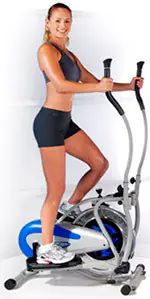People are interested in how to exercise on an elliptical trainer, having heard about the downright magical properties of this sports miracle exercise machine, which allows, as if by magic, to create a chiseled athletic figure. And it doesn’t even matter at all what physical state your body was in initially.
But those who think so will be severely disappointed. There is only one such magic wand in the world - the surgeon's scalpel. For everything else, you need to sweat a lot to achieve any significant results. And this word could not be more appropriate here. After all, the more you sweat, the better the results of your training will be and the sooner some effect will begin to appear.
Here many will say something like “it’s so uninteresting” or “you have to sweat everywhere, what’s so special?” But there really are differences. And they are quite significant:
- The load on the spine and joints is minimal.
- You can train both legs and arms.
- Small dimensions.
- Excellent reliability.
- Simplicity.
The first two points are the most interesting for athletes. Now you don’t have to worry about the fact that your spine suffers with every step (as happens when training on a treadmill), and, having only one sports equipment at home, you can keep your whole body in good shape.
The nuances of working on an elliptical trainer and basic exercises:
But let's return to the question with which we started: how to exercise on an elliptical trainer? There is some variety here, unlike the same treadmill or exercise bike, where all we can actually do is increase the load, simulating the inclines of the road.
Here are some basic examples of what you need to change in your movements to target different muscle groups:
- Let's start with the fact that by simply working your legs harder or, conversely, moving your arms more actively, you can train the muscles of the lower and upper body in turn.
- If you stay straight, the load will be evenly distributed between all four limbs. This way, by the way, you can find out which muscle groups of yours need training more than others.
- With reverse movements, you focus on developing the gluteal muscles and patellar tendon. These groups also train by tilting the center of gravity as far back as possible.
- Leaning forward slightly will put the stress on your quads and calves.



